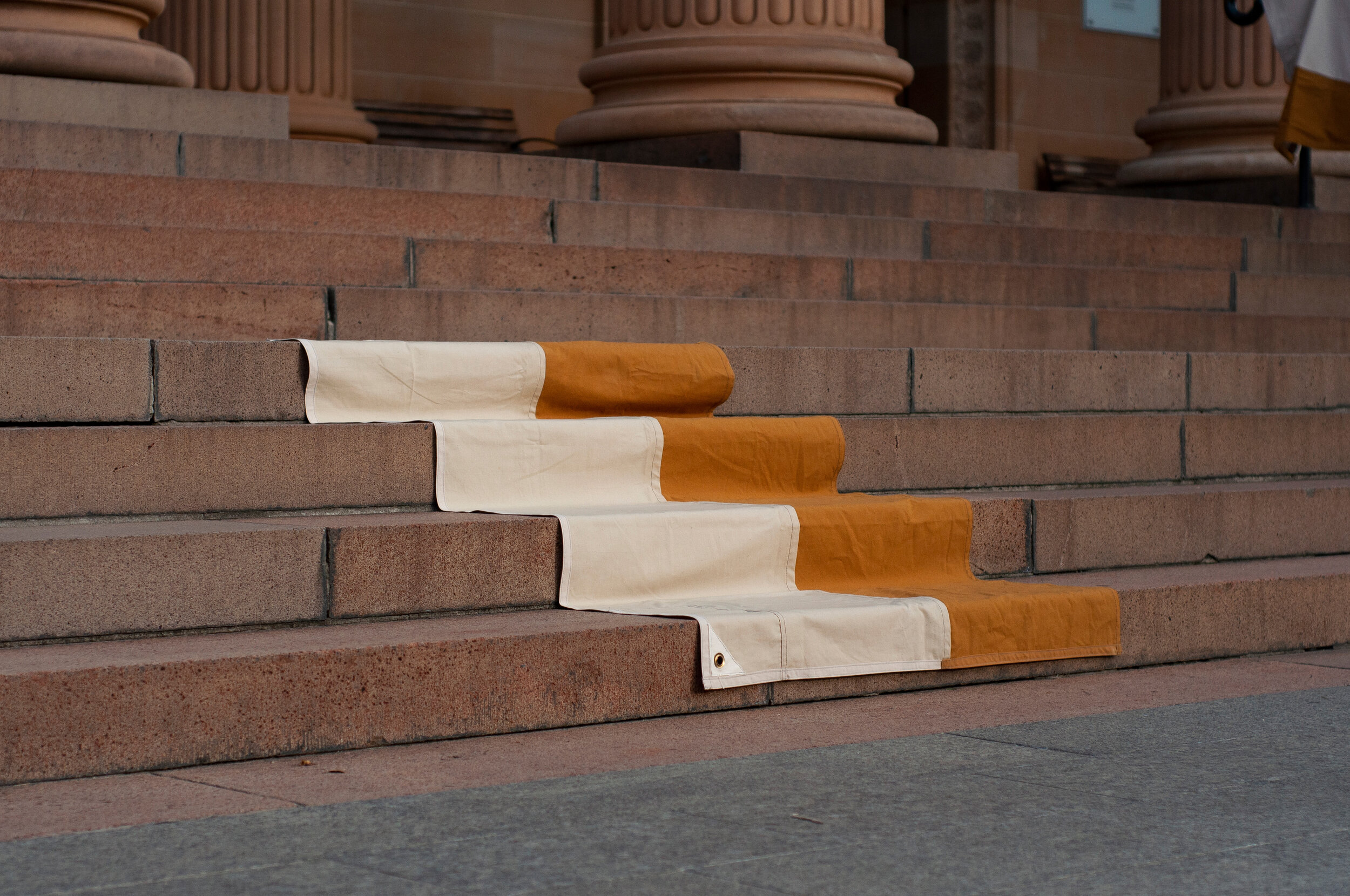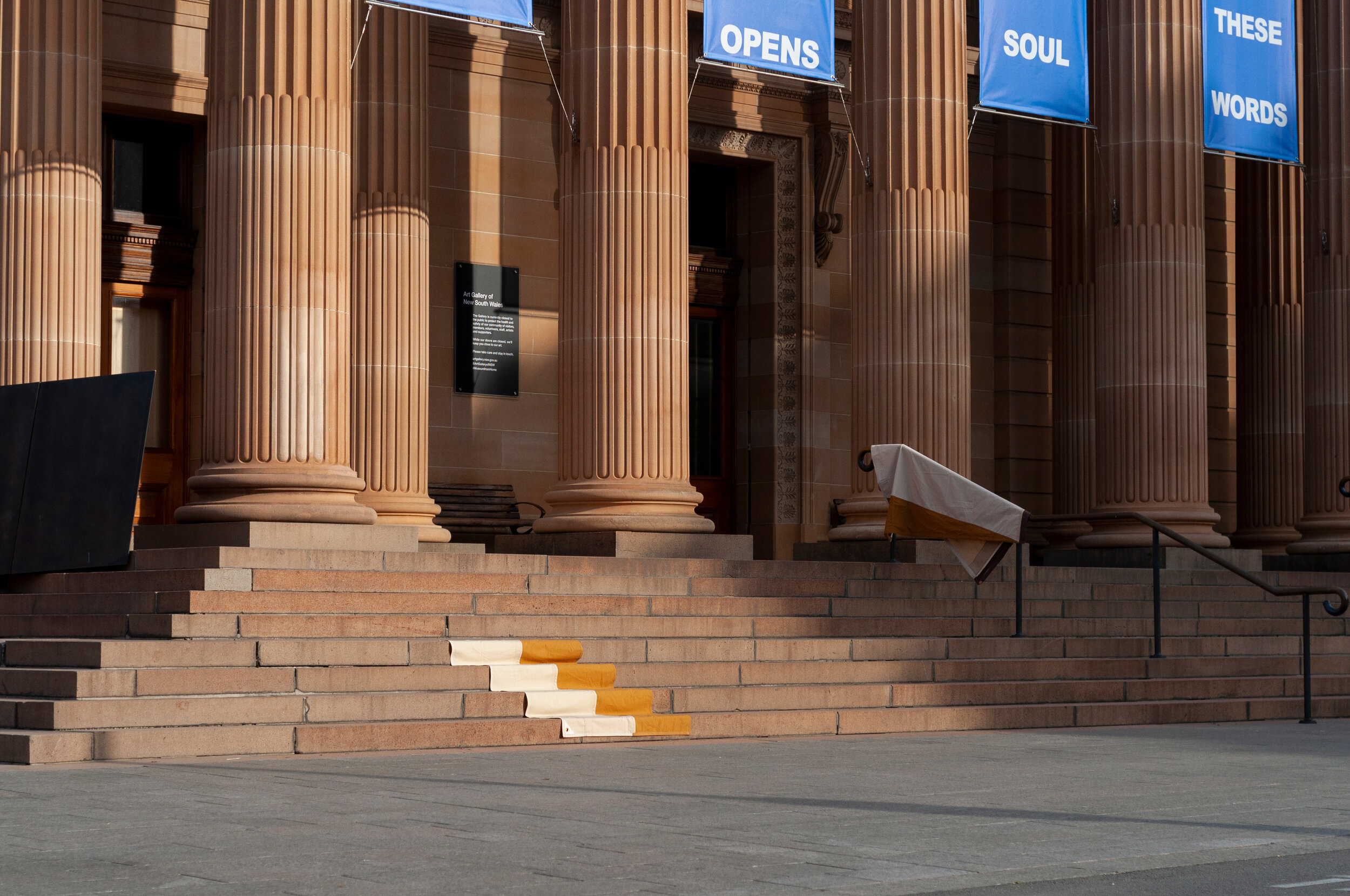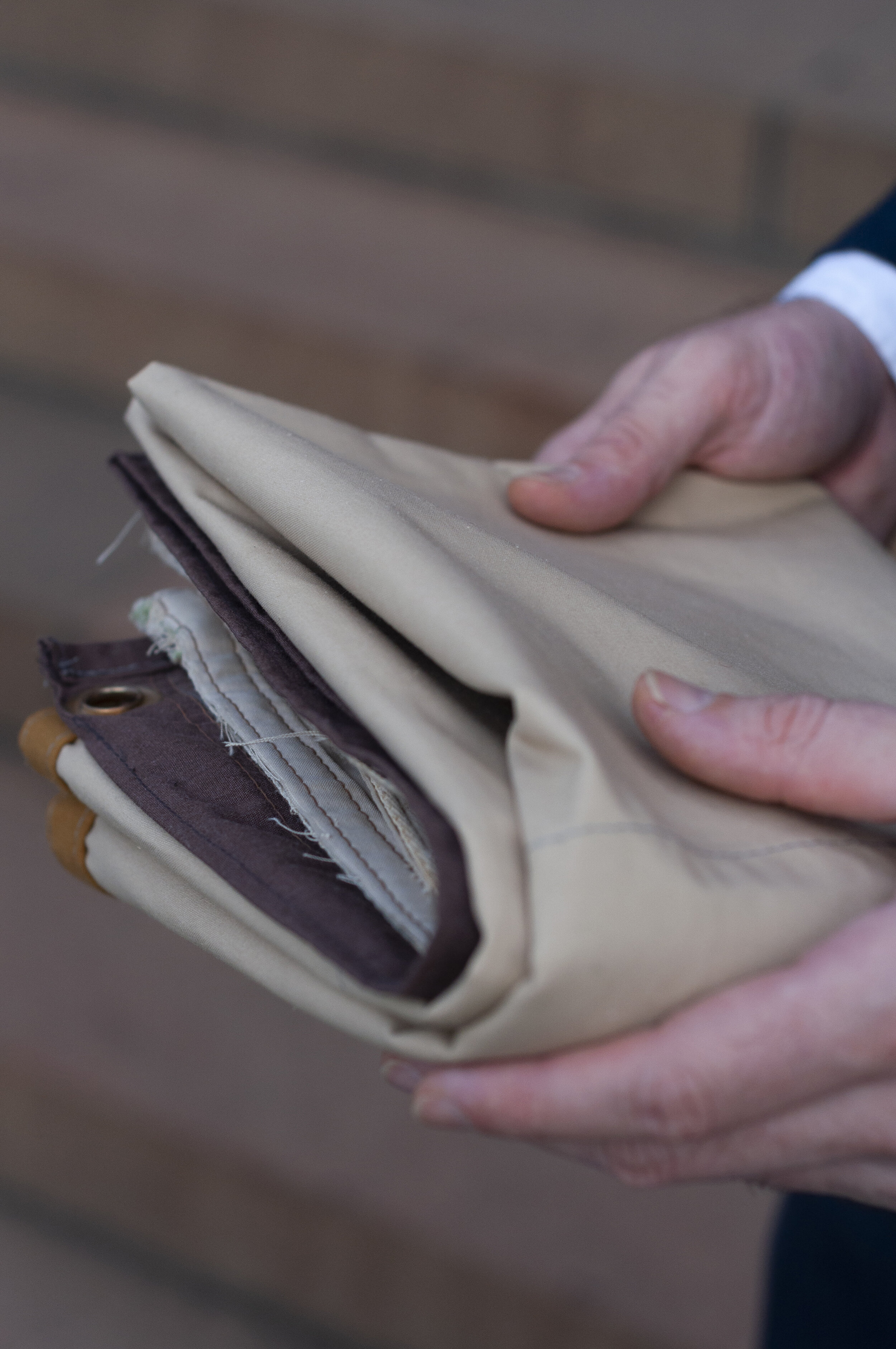In response to the current pandemic and the ongoing issues facing the broader arts community, TwentyOne invites Joe Wilson and Chanelle Collier to respond to the closure of the Art Gallery of NSW.
This collaboration between TwentyOne and the artists takes the form of a site-specific gesture. Wilson and Collier make use of their iconographic tent fabrics as a marker of presentness, by clothing the steps and handrails as an act of care that alludes to the Museum as a space of refuge and site of intimacy.
This gesture resounds with particular poignancy within the current context, which has completely shifted the way we move through the world. The tactile nature of this materiality and the sense of tenderness it evokes, recalls prior realities where seeing and touching were not dictated.
Documentation courtesy of TwentyOne
Download PDF CATALOGUE
TwnetyOne is a curatorial program which recognises the importance of site-specificity in exhibition programming. Operating outside of the traditional gallery space, TwentyOne seeks to promote contemporary practices ephemerally displayed within built and natural environments. The documentation of installations takes the form of an online archive which becomes the exhibition space itself. This program is by invitation, working with dedicated artists who will engage with the ethos of TwentyOne.
We (Joe and Chan) have had the privilege of being invited by TwentyOne, to perform work for photo documentation on site at the Art Gallery of New South Wales. Placing existing material work into contact with the gallery, as a site closed to the public because of the health emergency. These activities were conducted on the cusp of citywide lockdown.
This TwentyOne 002 documentation has a few significant ideas that relate to our current studio practices. We have been considering how one approaches the Museum as both a subject and a subjective body. This direction of work is about encounters between an institutional body and the personal body. The institution as a complex system that is met by the public, artists of renown and emerging, and also the individual staff members that work within it. Especially at this time when Museums are closed due to Covid 19, we have a chance to reflect upon the Museum’s signification and important cultural role. We take this opportunity for crisis to become an active agent; one capable of meeting a set of circumstances with a new engagement to a conditional reality. We are uniquely presented with a generative point of departure for reimagining contemporary practice.
There was only a short preliminary meeting and phone call to organise and plan an approach to this project. An important condition that everyone agreed on, was that it was to be a response to these times, to the gallery’s closure. We want the work to be with the site, reaching it.
We used tent fabric that has its own historical origin. Used it as a marker of collective presence in the here and now, by clothing the steps of the AGNSW as an act of care giving. To make use of the Museum as an infrastructure of refuge and as a site of intimacy.
On arrival, with our loose napkin drawing plan, we hadn’t consciously decided on a vibe. But the work spoke easily. Our soft approach was a laying on, to drape, and to place. Gentle gestures so as not to encroach, just respond. The tents and sections of, are soft structures that met wtih the hard surfaces of the gallery. It spoke of care. Hand rails evocative of touch, steps alluding to a heightening, and the powerful curved steel of an access ramp lending its sheltering structure.
I'm thinking of the photographic intervention as an extension of two recent projects. This Is Not A Love Song (Sound Archive), where we are recording inside museums. This is also centred on making an encounter with the institution, one that is personal. The project takes sound inherently of the museum, and makes it available via an accessible archive. The second relatable project is Post Gallery (With All Our Love) which examines the closed gallery. As artists we performed an act of caregiving by cleaning an art gallery’s windows. Audience members couldn't enter the closed gallery and this affectively aestheticized it by drawing attention to its non-use and defunctionalisation. The gallery was activated in this way as an object of consideration.
We find ourselves in a similar circumstance with the forced closure of our institutions. A loss of access closes an experience. It creates a distance, one that by circumstance has to be bridged virtually. Does this offer a critical distance? The imperative forces a reassessment and revaluation of the online tools that have penetrated our experiences, and only now seem so relevant as they become the default.
The materials we have used are refashioned from pioneer Andre Jamet’s French brand of tents from 1968. The year corresponds to both a peak in recreational camping activities as well as global civil rights movement of protests; including the revolutionary May ‘68 workers strikes in Paris. As a cultural object, the tent carries varied associations with urban escape and political action. It denotes the polarities of camping and protest, recreation and hardship, nostalgia and destitution. In this way, our use of the tent fabric is a means of tethering the work to its material heritage. For us this conceptually tethers the work to central concepts in our practice. It is through using the tent fabric that we have come to find three thematic pillars: FREEDOM, RESISTANCE, and LABOUR.
In its simplest breakdown, freedom is our inspo for humour, a do whatever you want drive informed by a do it anyway attitude. Resistance has had a long red thread through our work, what we tend to resist is the very systems we think we’re beholden to, especially within the arts. Labour is really just the working through, our occupational hazards, and being forced to assess its mostly de-commodified status in relation to other forms of labour, compensated or not.
Working from a disciplinary base of Painting, our work engages with both analogue and digital forms (through documentation) to articulate contemporary social relations to the image as a pervasive and penetrating force embedded within everyday life. This sense extends to objects also. Borrowing from Guy Debord’s premise that everyday life has literally been colonised by social relations mediated by images; we have continued to develop situations that can yield a collective praxis. Something that exceeds both commodity and power by utilising the work’s presentation as a strategic terrain to develop a shared community action that sits outside a normal art exhibition context.
Our collaboration with TwentyOne brings these underlying missions into parallel. To be conscious of site as a contingent imperative, and to work within a contributively extended art-making family. TwentyOne is an Instagram specific gallery experience.
Instagram as a platform for exhibition is a banal site, or rather a transaesthetic site. One that is indifferent to categorisation of high and low cultural forms. It is at its core a social media, and therefore is implicitly a conduit for social relations. Any medium has a context, materially embedded in the world, and denotive of the world.
An approach to the art gallery as a semi-performative site of labour positions it as a stage. In the theatre of practice a stage is central to a collective praxis that leverages creativity.
Something that is staged can mean something that is faked or recreated. Equally, staged can mean something done actually, such as staging an intervention for someone with an addiction, or an offensive staged by the military. The stage supports an act and evokes the act, it is inherently an anticipatory site of performance. It is a literal physical support for actors, but also a temporal space looking forward and backward in potentiality and happening. When there is no performance the empty stage waits, it holds space, it holds the previous memories of action in wear and tear, and it anticipates the future. This is just a reflection on the potential of a site, as a meeting place for a disparate action.
Regarding the Museum, a distance is created between the viewing body and the artwork through a variety of devices. These devices include the architecture, objects, surveillance, labour, and alarms. This distance protects the work from the viewer. There is something we are not allowed to see, or something that is not supposed to be experienced. Viewers are excluded from the reality of a work of art, from the banality of it, such as its verso side or weight. Is it critical that there is distance? The artwork gains an aura of security. It is presented and pushed out from the everyday, rarefied, and pushed beyond the bounds of everyday people. Critical distance is lost when the conditions that dictate its presentation, the encounter, appear to be normal.
Finishing up, TwentyOne 002 takes part in the program’s investment in an alternate gallery space. An online space in the public square that is Instagram. It’s a prescient and necessary adjustment while we experience Love In The Time Of Corona. We have this opportunity to approach our shared condition with consideration and care; if we care to consider. Rhetoric surrounds and demands quick action, and spontaneous creativity mixed with makeshift ‘getting it done’ attitude has released a smooth flow to an exhibition/event/response/documentation that we are extremely happy with. Taking existing resources and looking to how the world has changed and more precisely, closed. There’s a confrontation with the relations we knew, a yawning distance from the familiar and now all mediated as fuck. Best to stay occupied.
Joe and Chanelle










